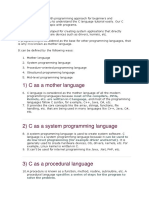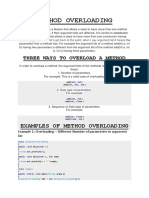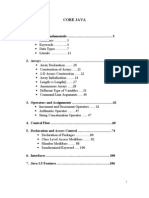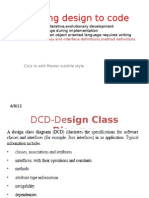Module 4
Uploaded by
Aireen BriosoModule 4
Uploaded by
Aireen BriosoAN OUTCOMES-BASED APPROACH ON Data structures and Algorithm
2 hours lecture & 3 hours laboratory
DATA STRUCTURES AND ALGORITHM Version1
Module 4: Pointers
I. INTRODUCTION:
Some C++ programming tasks are performed more easily with pointers, and other tasks, such
as dynamic memory allocation, cannot be performed without using pointers. So it becomes
necessary to learn pointers to become a perfect C++ programmer. Let's start learning them in
simple and easy steps.
As you know every variable is a memory location and every memory location has its address
defined which can be accessed using ampersand (&) operator which denotes an address in
memory. Consider the following which will print the address of the variables defined
II. LEARNING OBJECTIVES
At the end of the lesson, the students are expected to:
Learn about Pointers in C++
Learn the similarities and differences between pointers and references
Use pointers to pass arguments to function by reference
Understand the close relationships between pointers and built-in arrays
Use pointer-based strings
Use built-in arrays
III. LEARNING CONTENT
A. TOPIC DISCUSSIONS
WHAT IS POINTERS?
A pointer is a variable whose value is the address of another variable. Like any variable or
constant, you must declare a pointer before you can work with it. The general form of a pointer
variable declaration is –
Here, type is the pointer's base type; it must be a valid C++ type and var-name is the
name of the pointer variable. The asterisk you used to declare a pointer is the same asterisk that
you use for multiplication. However, in this statement the asterisk is being used to designate a
variable as a pointer. Following are the valid pointer declaration –
Authors : jnfadrilan@yahoo.com Page | 1
AN OUTCOMES-BASED APPROACH ON Data structures and Algorithm
2 hours lecture & 3 hours laboratory
DATA STRUCTURES AND ALGORITHM Version1
The actual data type of the value of all pointers, whether integer, float, character, or
otherwise, is the same, a long hexadecimal number that represents a memory address. The
only difference between pointers of different data types is the data type of the variable or
constant that the pointer points to.
Example 1: Pointer operators & and *
#include <iostream>
using namespace std;
int main () {
int var = 20; // actual variable declaration.
int *ip; // pointer variable
ip = &var; // store address of var in pointer variable
cout << "Value of var variable: ";
cout << var << endl;
// print the address stored in ip pointer variable
cout << "Address stored in ip variable: ";
cout << ip << endl;
// access the value at the address available in pointer
cout << "Value of *ip variable: ";
cout << *ip << endl;
return 0;
}
When the above code is compiled and executed, it produces result something as follows –
Example 2: Using the Address (&) and Indirection (*) Operators
The program in below demonstrates the & and * pointer operators. Memory locations are
output by << in this example as hexadecimal (i.e., base-16) integers. The memory addresses
output by this program are platform dependent, so you may get different results when you run the
program. The address of a (line 11) and the value of aPtr (line 12) are identical in the output,
confirming that the address of a is indeed assigned to the pointer variable aPtr.
Authors : jnfadrilan@yahoo.com Page | 2
AN OUTCOMES-BASED APPROACH ON Data structures and Algorithm
2 hours lecture & 3 hours laboratory
DATA STRUCTURES AND ALGORITHM Version1
Output:
PASS-BY-REFERENCE WITH POINTERS
There are three ways in C++ to pass arguments to a function, pass-by-value, pass-by-
reference with reference arguments and pass-by-reference with pointer arguments.
You can use pointers and the indirection operator (*) to accomplish pass-by-reference
(exactly as pass-by-reference is done in C programs—C does not have references). When
calling a function with an argument that should be modified, the address of the argument is
passed. This is normally accomplished by applying the address operator (&) to the name of the
variable whose value will be modified.
The program below passes variable number by value (line 14) to function cubeByValue
(lines 19–22), which cubes its argument and passes the new value back to main using a return
statement (line 21). The new value is assigned to number (line 14) in main. The calling function
has the opportunity to examine the function call’s result before modifying variable number’s
value. For example, we could have stored the result of cubeByValue in another variable,
examined its value and assigned the result to number only after determining that the returned
value was reasonable.
Authors : jnfadrilan@yahoo.com Page | 3
AN OUTCOMES-BASED APPROACH ON Data structures and Algorithm
2 hours lecture & 3 hours laboratory
DATA STRUCTURES AND ALGORITHM Version1
Example 3: Pass-by-value used to cube a variable’s value.
Output:
Authors : jnfadrilan@yahoo.com Page | 4
AN OUTCOMES-BASED APPROACH ON Data structures and Algorithm
2 hours lecture & 3 hours laboratory
DATA STRUCTURES AND ALGORITHM Version1
Example 4: Pass-by-Reference with Pointers
Output:
A function receiving an address as an argument must define a pointer parameter to
receive the address. For example, the header for function cubeByReference (line 21) specifies
that cubeByReference receives the address of an int variable (i.e., a pointer to an int) as an
argument, stores the address in nPtr and does not return a value.
Function cubeByReference’s prototype (line 7) contains int * in parentheses. As with
other types, it isn’t necessary to include the names of pointer parameters in prototypes.
Parameter names included for documentation purposes are ignored by the compiler.
GRAPHICAL ANALYSIS OF PASS-BY-VALUE AND PASS-BY-REFERENCE
In the diagrams, the values in blue rectangles above a given expression or variable
represent the value of that expression or variable. Each diagram’s right column shows functions
cubeByValue (Example 3) and cubeByReference (Example 4) only when they’re executing.
Authors : jnfadrilan@yahoo.com Page | 5
AN OUTCOMES-BASED APPROACH ON Data structures and Algorithm
2 hours lecture & 3 hours laboratory
DATA STRUCTURES AND ALGORITHM Version1
Authors : jnfadrilan@yahoo.com Page | 6
AN OUTCOMES-BASED APPROACH ON Data structures and Algorithm
2 hours lecture & 3 hours laboratory
DATA STRUCTURES AND ALGORITHM Version1
Before main calls cubeByReference:
Authors : jnfadrilan@yahoo.com Page | 7
AN OUTCOMES-BASED APPROACH ON Data structures and Algorithm
2 hours lecture & 3 hours laboratory
DATA STRUCTURES AND ALGORITHM Version1
B. SUPPLEMENTARY MATERIALS
1. https://www.youtube.com/watch?v=8ViFuvTezIc
2. https://www.programiz.com/cpp-programming/pointers
3. https://www.tutorialspoint.com/cplusplus/cpp_references.htm
IV. LEARNING ACTIVITIES
A. Laboratory Work
U Understanding
AP Applying
ASSESSMENT
AN Analyzing
E Evaluating
C Creating
Authors : jnfadrilan@yahoo.com Page | 8
You might also like
- Name: - Roll No: - Score: - Signature of The Lab Tutor: - DateNo ratings yetName: - Roll No: - Score: - Signature of The Lab Tutor: - Date8 pages
- Procedural Concept: - The Main Program Coordinates Calls To Procedures and Hands Over Appropriate Data As ParametersNo ratings yetProcedural Concept: - The Main Program Coordinates Calls To Procedures and Hands Over Appropriate Data As Parameters29 pages
- Procedural Concept: - The Main Program Coordinates Calls To Procedures and Hands Over Appropriate Data As ParametersNo ratings yetProcedural Concept: - The Main Program Coordinates Calls To Procedures and Hands Over Appropriate Data As Parameters29 pages
- Chapter 5 - Pointers: 2003 Prentice Hall, Inc. All Rights ReservedNo ratings yetChapter 5 - Pointers: 2003 Prentice Hall, Inc. All Rights Reserved48 pages
- Data Structures and Algorithms: Introduction To PointersNo ratings yetData Structures and Algorithms: Introduction To Pointers13 pages
- CO1508 Computer Systems & Security - Week 11 C++ Pointers and More For Your Virus/Anti-virus - Part 2No ratings yetCO1508 Computer Systems & Security - Week 11 C++ Pointers and More For Your Virus/Anti-virus - Part 212 pages
- Computer Programming Laboratory Experiment # 1: Pointers I ObjectivesNo ratings yetComputer Programming Laboratory Experiment # 1: Pointers I Objectives5 pages
- Algorithms Data Structures GATE Computer Science Postal Study MaterialNo ratings yetAlgorithms Data Structures GATE Computer Science Postal Study Material15 pages
- Unit - Iii: Malla Reddy Engineering College For WomenNo ratings yetUnit - Iii: Malla Reddy Engineering College For Women35 pages
- CP+Spring2011+-+Lecture+5+ Pointers+ +stringsNo ratings yetCP+Spring2011+-+Lecture+5+ Pointers+ +strings42 pages
- Chapter 5 - Pointers and Strings: 2003 Prentice Hall, Inc. All Rights ReservedNo ratings yetChapter 5 - Pointers and Strings: 2003 Prentice Hall, Inc. All Rights Reserved86 pages
- COMPBBE39312rObjrBh - OOP UNIT 2 PointersNo ratings yetCOMPBBE39312rObjrBh - OOP UNIT 2 Pointers59 pages
- Lecture 02: Pointers: Engr. Muhammad Asad Lecturer (EE) Institute of Space Technology, Islamabad Muhammad - Asad@ist - Edu.pkNo ratings yetLecture 02: Pointers: Engr. Muhammad Asad Lecturer (EE) Institute of Space Technology, Islamabad Muhammad - Asad@ist - Edu.pk14 pages
- C For Engineers and Scientists 4th Edition Bronson Solutions Manual100% (39)C For Engineers and Scientists 4th Edition Bronson Solutions Manual7 pages
- "Datetype.H": #Include #Include #Include #IncludeNo ratings yet"Datetype.H": #Include #Include #Include #Include2 pages
- Work With File Handling: © Dukestar Technologies Pvt. Ltd. 1/12No ratings yetWork With File Handling: © Dukestar Technologies Pvt. Ltd. 1/1212 pages
- Send Us Your Comments Preface What's New in PL/SQL? 1 Overview of PL/SQLNo ratings yetSend Us Your Comments Preface What's New in PL/SQL? 1 Overview of PL/SQL14 pages
- New and Changes Queries Details (9.6.3)No ratings yetNew and Changes Queries Details (9.6.3)43 pages
- Name:Parth Gala Roll NP:16010421025 Batch:B3: Doctype HTML Head Head Body h1 h1 ?PHPNo ratings yetName:Parth Gala Roll NP:16010421025 Batch:B3: Doctype HTML Head Head Body h1 h1 ?PHP5 pages
- Method Overloading: Three Ways To Overload A MethodNo ratings yetMethod Overloading: Three Ways To Overload A Method6 pages
- Assignments: Program: BSC It Semester-IvNo ratings yetAssignments: Program: BSC It Semester-Iv14 pages
- Capgemini Frequent Questions+Previous Year100% (1)Capgemini Frequent Questions+Previous Year57 pages
- Name: - Roll No: - Score: - Signature of The Lab Tutor: - DateName: - Roll No: - Score: - Signature of The Lab Tutor: - Date
- Procedural Concept: - The Main Program Coordinates Calls To Procedures and Hands Over Appropriate Data As ParametersProcedural Concept: - The Main Program Coordinates Calls To Procedures and Hands Over Appropriate Data As Parameters
- Procedural Concept: - The Main Program Coordinates Calls To Procedures and Hands Over Appropriate Data As ParametersProcedural Concept: - The Main Program Coordinates Calls To Procedures and Hands Over Appropriate Data As Parameters
- Chapter 5 - Pointers: 2003 Prentice Hall, Inc. All Rights ReservedChapter 5 - Pointers: 2003 Prentice Hall, Inc. All Rights Reserved
- Data Structures and Algorithms: Introduction To PointersData Structures and Algorithms: Introduction To Pointers
- CO1508 Computer Systems & Security - Week 11 C++ Pointers and More For Your Virus/Anti-virus - Part 2CO1508 Computer Systems & Security - Week 11 C++ Pointers and More For Your Virus/Anti-virus - Part 2
- Computer Programming Laboratory Experiment # 1: Pointers I ObjectivesComputer Programming Laboratory Experiment # 1: Pointers I Objectives
- Algorithms Data Structures GATE Computer Science Postal Study MaterialAlgorithms Data Structures GATE Computer Science Postal Study Material
- Unit - Iii: Malla Reddy Engineering College For WomenUnit - Iii: Malla Reddy Engineering College For Women
- Chapter 5 - Pointers and Strings: 2003 Prentice Hall, Inc. All Rights ReservedChapter 5 - Pointers and Strings: 2003 Prentice Hall, Inc. All Rights Reserved
- Lecture 02: Pointers: Engr. Muhammad Asad Lecturer (EE) Institute of Space Technology, Islamabad Muhammad - Asad@ist - Edu.pkLecture 02: Pointers: Engr. Muhammad Asad Lecturer (EE) Institute of Space Technology, Islamabad Muhammad - Asad@ist - Edu.pk
- C For Engineers and Scientists 4th Edition Bronson Solutions ManualC For Engineers and Scientists 4th Edition Bronson Solutions Manual
- Work With File Handling: © Dukestar Technologies Pvt. Ltd. 1/12Work With File Handling: © Dukestar Technologies Pvt. Ltd. 1/12
- Send Us Your Comments Preface What's New in PL/SQL? 1 Overview of PL/SQLSend Us Your Comments Preface What's New in PL/SQL? 1 Overview of PL/SQL
- Name:Parth Gala Roll NP:16010421025 Batch:B3: Doctype HTML Head Head Body h1 h1 ?PHPName:Parth Gala Roll NP:16010421025 Batch:B3: Doctype HTML Head Head Body h1 h1 ?PHP
- Method Overloading: Three Ways To Overload A MethodMethod Overloading: Three Ways To Overload A Method

























































































